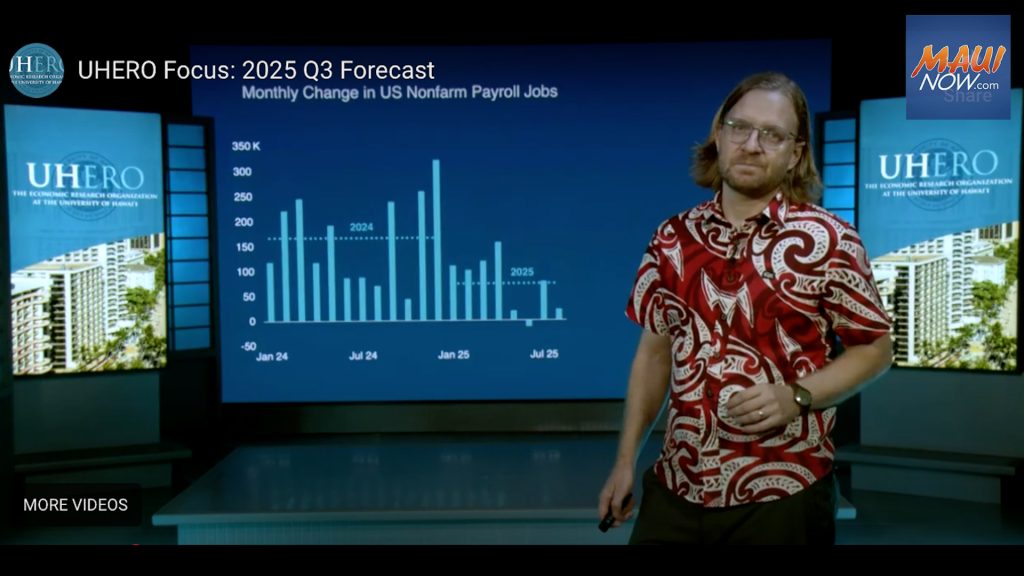The University of Hawaiʻi Economic Research Organization (UHERO) forecasts a mild recession in the islands over the next year, with the weakening US economy threatening a potentially deeper downturn.
Hawaiʻi’s economic prospects remain poor, US trade policy is impacting key international visitor markets, and tariffs and uncertainty weigh on the US economy, according to the UHERO third quarter forecast for 2025.
In Hawaiʻi, visitor numbers are down, job growth has stalled, and housing activity remains weak, according to the report. UHERO notes that Inflation will rise over the next year as tariffs feed through to consumer prices. Construction, UHERO reports, remains the only major source of strength, supported by large federal contracts and other public projects.
The following UHERO highlights including takeaways for Maui are included below:
Construction is the only growth support
Hawai‘i’s sole area of resilience continues to be construction, where recently announced military construction, ongoing Skyline work and Aloha Stadium redevelopment will sustain industry employment near 40,000 jobs through the end of the decade. Maui rebuilding will also support the industry. The biggest risk to the sector is the impact of tariffs on the cost of materials.
Condo markets are the weakest they have been since 2010, partly because of high mortgage rates and surging insurance costs. The Maui condo market has seen a large plunge in activity, with the value of resales down nearly 50% compared with mid-2023. This reflects in part uncertainty over Bill 9, a proposal to phase out transient vacation rentals in apartment districts. The fate of this bill remains uncertain.
US and global conditions worsen
Signs of US weakness are increasingly evident, UHERO wrote. Consumer spending has slowed to a near standstill, and, outside of health care, the number of jobs has ceased to grow and may have begun to contract. The national unemployment rate remains stable only because of the loss of foreign-born workers. Abroad, Canada has fallen into recession as tariffs cause exports to plunge. Japan’s modest recovery will slow as exports fall and interest rates rise. Other key Hawaiʻi visitor markets face similar strains. A deeper global slowdown would inevitably rebound on Hawai‘i’s economy through weaker tourism demand.
Stalling labor markets will see widespread losses
Hawai‘i payroll job growth has stalled since March, leaving employment 15,000 jobs below pre-pandemic levels. Many sectors are now contracting, led by federal job losses and tourism sector declines. The drop in federal jobs—down more than 1,200 already—will deepen as deferred resignations take effect at the end of this month. Payrolls are projected to fall through late 2026 before a slow recovery begins.
UHERO reports that tourism officials and industry players look to high-volume tourism events to draw in significant numbers of visitors and generate industry revenue. “Near-term prospects were dealt a setback with the recent cancellation of the Sentry golf tournament in Kapalua, because of the current water scarcity on Maui. The loss of this high-profile professional golf event will add to the headwinds facing an already lagging tourism recovery on Maui,” according to the document.
Tariffs are hitting Hawai‘i tourism hard
Visitor industry conditions deteriorated mid-year, and seasonally adjusted arrivals fell 8% between April and July. International markets have seen the biggest losses, with the Canadian visitor census down 9%. That leaves Hawai‘i dependent on a continental US market that is vulnerable to a US recession. While losses to date are a bit smaller than anticipated last spring, UHERO sees arrivals about 5% lower than last year by the middle of 2026; real visitor spending will decline by more than $600 million.
According to the UHERO report, “Although the falling visitor census will stabilize by the middle of next year, none of the counties except Maui will reclaim their 2024 levels until 2028.”
Inflation will weigh on households
Honolulu inflation receded to 2.3% in July, even as overall US inflation picked up. The gradual pass-through of tariffs will lift consumer price index inflation to about 4% at the end of next year before it begins to ease. By 2026, inflation will have lifted local prices by an average of 1.5% more than it would have been, permanently raising typical household costs by roughly $1,400 annually. State income tax relief worth about $2,000 for the median-income household will help to support purchasing power, but federal SNAP and Medicaid cuts will remove benefits for tens of thousands, hitting the lowest-income families hardest.
UHERO’s mild recession forecast faces growing downside risks
UHERO continues to expect that a mild Hawai‘i recession is imminent. There will be periods of contraction in payroll jobs, real GDP and personal income, combined with higher inflation. A gradual recovery will begin by late next year. Risks are now more clearly tilted to the downside. A US recession would compound global weakness, while prolonged high tariffs, stricter immigration enforcement and deep federal spending cuts could intensify local impacts. Even if the recession proves shallow, higher prices and tepid growth will impose ongoing costs on Hawai‘i households.
